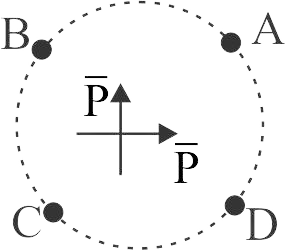359332 A short electric dipole has a dipole moment of \(16 \times {10^{ - 9}}\,cm\). The electric potential due to the dipole at a point at a distance of 0.6 \(m\) form the center of the dipole, situated on a line making an angle of \(60^\circ \) with the dipole axis is :\(\left( {\frac{1}{{4\pi {\varepsilon _0} = 9}} \times {{10}^9}N{m^2}/{C^2}} \right)\)
359334
An electric dipole of moment \(\overrightarrow p \) is placed in a uniform electric field \(\overrightarrow E \). Then
(i) the torque on the dipole is \(\overrightarrow p \times \overrightarrow E \).
(ii) the potential energy of the system is \( - \overrightarrow p \cdot \overrightarrow E \)
(iii) the resultant force on the dipole is zero
359332 A short electric dipole has a dipole moment of \(16 \times {10^{ - 9}}\,cm\). The electric potential due to the dipole at a point at a distance of 0.6 \(m\) form the center of the dipole, situated on a line making an angle of \(60^\circ \) with the dipole axis is :\(\left( {\frac{1}{{4\pi {\varepsilon _0} = 9}} \times {{10}^9}N{m^2}/{C^2}} \right)\)
359334
An electric dipole of moment \(\overrightarrow p \) is placed in a uniform electric field \(\overrightarrow E \). Then
(i) the torque on the dipole is \(\overrightarrow p \times \overrightarrow E \).
(ii) the potential energy of the system is \( - \overrightarrow p \cdot \overrightarrow E \)
(iii) the resultant force on the dipole is zero
359332 A short electric dipole has a dipole moment of \(16 \times {10^{ - 9}}\,cm\). The electric potential due to the dipole at a point at a distance of 0.6 \(m\) form the center of the dipole, situated on a line making an angle of \(60^\circ \) with the dipole axis is :\(\left( {\frac{1}{{4\pi {\varepsilon _0} = 9}} \times {{10}^9}N{m^2}/{C^2}} \right)\)
359334
An electric dipole of moment \(\overrightarrow p \) is placed in a uniform electric field \(\overrightarrow E \). Then
(i) the torque on the dipole is \(\overrightarrow p \times \overrightarrow E \).
(ii) the potential energy of the system is \( - \overrightarrow p \cdot \overrightarrow E \)
(iii) the resultant force on the dipole is zero
359332 A short electric dipole has a dipole moment of \(16 \times {10^{ - 9}}\,cm\). The electric potential due to the dipole at a point at a distance of 0.6 \(m\) form the center of the dipole, situated on a line making an angle of \(60^\circ \) with the dipole axis is :\(\left( {\frac{1}{{4\pi {\varepsilon _0} = 9}} \times {{10}^9}N{m^2}/{C^2}} \right)\)
359334
An electric dipole of moment \(\overrightarrow p \) is placed in a uniform electric field \(\overrightarrow E \). Then
(i) the torque on the dipole is \(\overrightarrow p \times \overrightarrow E \).
(ii) the potential energy of the system is \( - \overrightarrow p \cdot \overrightarrow E \)
(iii) the resultant force on the dipole is zero


